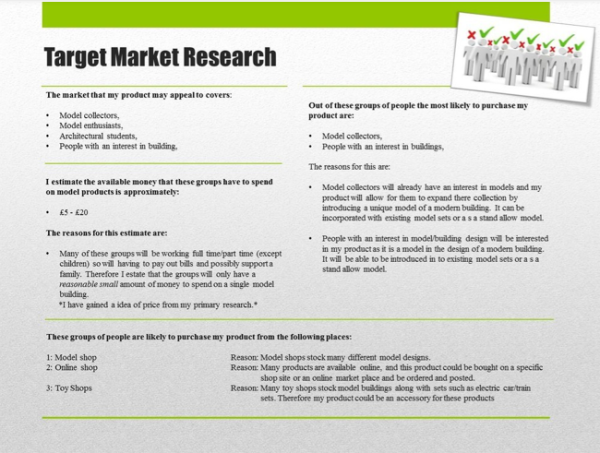
'Recognizing the need is the primary condition for design.'
Milton Glaser
Target Market Profie
Objectives:
List all of the possible buyers and users of your product
Analyse results to identify the three most likely groups to use or buy your product
Communicate the general demographics for each subgroup
Outcomes:
A list of possible buyers is generated
Results are analysed and general demographics of most advantageious groups identified
A written statement describing the age, income, gender, education level, attitudes, hobbies and interests, lifestyle etc. for each sector
Task 1 - List all of the possible buyers and users for your GCSE product
e.g.
Folding Hampster House Product:
Parents with pets
Young children with pets
Pet shops
Hamspter cage manufacturers
Can you think of any more?
Task 2 - Discuss your list generated in task 1 and then select the 3 most likely groups to purchace your product. Explain why you have chosen each group giving an example in each case
e.g.
Folding Hampster House Product:
Sector chosen:
Parents with pets - Parents are likely to have more money than children and may want to buy products for family pets.
Pet shops - Pet shops are going to want to sell kits and individual products
Hamspter cage manufacturers - These businesses may have other products to expand my range into, they sell to shops
Can you think of any more reasons for the above chosen sectors?
Task 3 - Communicate in writing in as much detail as possible the demographic information for each chosen market sector
e.g.
Parents with pets - Parents who can afford to keep pets are likely to have some disposable income so one or more of them is proberly employed. An average wage in the country is currently £26,500. Parents are suseceptable to 'nagging' from their children which could lead them to purchace a pet and products to keep the pet housed.
Retailers - I would mainly be selling my product to retailers (shops) and parents.Hamster houses sell from £2.50 - £16 so I could place my product retail price in this range.Rretailers are likely to be cost aware and looking for a good price. I could approach individual shop owners and chains, the demographics for each group would be quite wide from low - high income and of any age group.
Use the information and steps below to help you create your demographic statements
-
1Identify your target market. It is difficult to meet everyone's needs with a single product or service. Identifying your target market will help you use your resources more wisely as you market your company to a specific, manageable group of people.
- List all potential consumers. Include individual buyers, as well as other businesses and middlemen who re-sell your product to
others.
- Segment your audience. Split them up into different groups of consumers, such as small business owners, office supply stores, or
young families.
- Determine who will benefit from your product or service the most. This is your target audience. Though you do not exclude other
potential consumers from your marketing, focus your marketing campaign on this group.
- List all potential consumers. Include individual buyers, as well as other businesses and middlemen who re-sell your product to
others.
-
2Describe your target market demographically. Demographic characteristics include age, gender, marital status, family size, income, education level, occupation, race, and religion.
- Demographic information can often be found online as a compilation of different reports the federal government runs. Check the Census
Bureau and Commerce Department websites.
- For businesses, demographical information includes where the business is located, how many branches they have, their annual revenue,
number of employees, industry, and how long the business has been running.
- Demographic information can often be found online as a compilation of different reports the federal government runs. Check the Census
Bureau and Commerce Department websites.
-
3Describe your target market psycho-graphically. Psycho graphic information tells you about your audience's attitudes, beliefs, emotions, and values. It includes your target market's family stage, hobbies and interests, type of entertainment they engage in, and lifestyle.
- Psychographic information is often found through surveys or focus groups. Though you can set these up yourself, it would be
beneficial to hire a marketing research firm to help you structure the surveys, word questions carefully, and engage with focus groups in an effective way.
- For businesses, psychographic information can include the company's values or motto, how they wish to be seen by their own customers,
and how formal or informal their work environment is.
- Psychographic information is often found through surveys or focus groups. Though you can set these up yourself, it would be
beneficial to hire a marketing research firm to help you structure the surveys, word questions carefully, and engage with focus groups in an effective way.
-
4Describe your target market behavioristically. Behavioristic information helps you understand why someone purchases one product or service over another. It includes how often your target market buy the product, how much or how many they buy, if there was a specific occasion for using it, and how long it took them to decide to buy that product.
- Determine how important brand or company loyalty is to your target market.
- Find out if your audience most heavily values convenience, a good price, or quality.
- Discover how your target market usually pays for your product or service via market surveys.
- Ask if your customers prefer face-to-face interaction or an online store.
- Determine how important brand or company loyalty is to your target market.
-
5Compile your results. This is your target market analysis, an in-depth look at the lifestyle and characteristics of your customers. Though you want to keep the information organized, format it in the way that works best for you and your organization.
- Consider using graphs to help your organization visualize different numbers and percentages.

